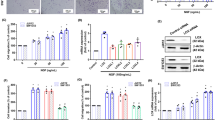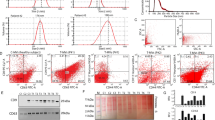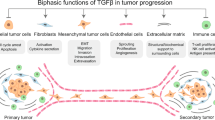Abstract
Imbalanced protease expression and activities may contribute to the development of cancers, including neuroblastoma (NB). NB is a fatal childhood cancer of the sympathetic nervous system that frequently overexpresses mitogenic peptides, chemokines and their receptors. Dipeptidyl peptidase IV (DPPIV), a cell surface serine protease, inactivates or degrades some of these bioactive peptides and chemokines, thereby regulating cell proliferation and survival. Our studies show that DPPIV is expressed in normal neural crest-derived structures, including superior cervical and dorsal root ganglion cells, sciatic nerve, and in adrenal glands, but its expression is greatly decreased or lost in cells derived from NB, their malignant counterpart. Restoration of DPPIV expression in NB cells led to their differentiation in association with increased expression of the neural marker MAP2 and decreased expression of chemokines, including stromal-derived factor 1 (SDF1) and its receptor CXCR4. Furthermore, DPPIV promoted apoptosis, and inhibited SDF1-mediated in vitro cell migration and angiogenic potential. These changes were accompanied by caspase activation and decreased levels of phospho-Akt and MMP9 activity, which are downstream effectors of SDF1-CXCR4 signaling. Importantly, DPPIV suppressed the tumorigenic potential of NB cells in a xenotransplantation mouse model. These data support a potential role for DPPIV in inhibiting NB growth and progression.
This is a preview of subscription content, access via your institution
Access options
Subscribe to this journal
Receive 50 print issues and online access
$259.00 per year
only $5.18 per issue
Buy this article
- Purchase on Springer Link
- Instant access to full article PDF
Prices may be subject to local taxes which are calculated during checkout






Similar content being viewed by others
References
Abbott CA, Gorrell MD, Levy MT, McCaughan GW . (1997). Molecular analyses of human and rat dipeptidyl peptidase IV. Adv Exp Med Biol 421: 161–169.
Airoldi I, Cocco C, Morandi F, Prigione I, Pistoia V . (2008). CXCR5 may be involved in the attraction of human metastatic neuroblastoma cells to the bone marrow. Cancer Immunol Immunother 57: 541–548.
Airoldi I, Raffaghello L, Piovan E, Cocco C, Carlini B, Amadori A et al. (2006). CXCL12 does not attract CXCR4+ human metastatic neuroblastoma cells: clinical implications. Clin Cancer Res 12: 77–82.
Balkwill F . (2004). Cancer and the chemokine network. Nat Rev Cancer 4: 540–550.
Barbero S, Bonavia R, Bajetto A, Porcile C, Pirani P, Ravetti JL et al. (2003). Stromal cell-derived factor 1alpha stimulates human glioblastoma cell growth through the activation of both extracellular signal-regulated kinases 1/2 and Akt. Cancer Res 63: 1969–1974.
Bauvois B . (2004). Transmembrane proteases in cell growth and invasion: new contributors to angiogenesis? Oncogene 23: 317–329.
Belmadani A, Tran PB, Ren D, Assimacopoulos S, Grove EA, Miller RJ . (2005). The chemokine stromal cell-derived factor-1 regulates the migration of sensory neuron progenitors. J Neurosci 25: 3995–4003.
Bogenrieder T, Finstad CL, Freeman RH, Papandreou CN, Scher HI, Albino AP et al. (1997). Expression and localization of aminopeptidase A, aminopeptidase N, and dipeptidyl peptidase IV in benign and malignant human prostate tissue. Prostate 33: 225–232.
Bonfil RD, Chinni S, Fridman R, Kim HR, Cher ML . (2007). Proteases, growth factors, chemokines, and the microenvironment in prostate cancer bone metastasis. Urol Oncol 25: 407–411.
Brodeur GM . (2003). Neuroblastoma: biological insights into a clinical enigma. Nat Rev Cancer 3: 203–216.
Burger JA, Kipps TJ . (2006). CXCR4: a key receptor in the crosstalk between tumor cells and their microenvironment. Blood 107: 1761–1767.
Carl-McGrath S, Lendeckel U, Ebert M, Rocken C . (2006). Ectopeptidases in tumour biology: a review. Histol Histopathol 21: 1339–1353.
Castel V, Grau E, Noguera R, Martinez F . (2007). Molecular biology of neuroblastoma. Clin Transl Oncol 9: 478–483.
Chinni SR, Sivalogan S, Dong Z, Filho JC, Deng X, Bonfil RD et al. (2006). CXCL12/CXCR4 signaling activates Akt-1 and MMP-9 expression in prostate cancer cells: the role of bone microenvironment-associated CXCL12. Prostate 66: 32–48.
Christopherson II KW, Hangoc G, Broxmeyer HE . (2002). Cell surface peptidase CD26/dipeptidylpeptidase IV regulates CXCL12/stromal cell-derived factor-1 alpha-mediated chemotaxis of human cord blood CD34+ progenitor cells. J Immunol 169: 7000–7008.
Dai J, Shen R, Sumitomo M, Goldberg JS, Geng Y, Navarro D et al. (2001). Tumor-suppressive effects of neutral endopeptidase in androgen-independent prostate cancer cells. Clin Cancer Res 7: 1370–1377.
Dinjens WN, Ten Kate J, Kirch JA, Tanke HJ, Van der Linden EP, Van den Ingh HF et al. (1990). Adenosine deaminase complexing protein (ADCP) expression and metastatic potential in prostatic adenocarcinomas. J Pathol 160: 195–201.
Dobers J, Grams S, Reutter W, Fan H . (2000). Roles of cysteines in rat dipeptidyl peptidase IV/CD26 in processing and proteolytic activity. Eur J Biochem 267: 5093–5100.
Durinx C, Lambeir AM, Bosmans E, Falmagne JB, Berghmans R, Haemers A et al. (2000). Molecular characterization of dipeptidyl peptidase activity in serum: soluble CD26/dipeptidyl peptidase IV is responsible for the release of X-Pro dipeptides. Eur J Biochem 267: 5608–5613.
Eggert A, Ikegaki N, Kwiatkowski J, Zhao H, Brodeur GM, Himelstein BP . (2000). High-level expression of angiogenic factors is associated with advanced tumor stage in human neuroblastomas. Clin Cancer Res 6: 1900–1908.
Fernandis AZ, Prasad A, Band H, Klosel R, Ganju RK . (2004). Regulation of CXCR4-mediated chemotaxis and chemoinvasion of breast cancer cells. Oncogene 23: 157–167.
Gabrilovac J, Abramić M, Uzarević B, Andreis A, Poljak L . (2003). Dipeptidyl peptidase IV (DPPIV) enzyme activity on immature T-cell line R1.1 is down-regulated by dynorphin-A (1-17) as a non-substrate inhibitor. Life Sci 73: 151–166.
Geminder H, Sagi-Assif O, Goldberg L, Meshel T, Rechavi G, Witz IP et al. (2001). A possible role for CXCR4 and its ligand, the CXC chemokine stromal cell-derived factor-1, in the development of bone marrow metastases in neuroblastoma. J Immunol 167: 4747–4757.
Gerard C, Rollins BJ . (2001). Chemokines and disease. Nat Immunol 2: 108–115.
Ghersi G, Dong H, Goldstein LA, Yeh Y, Hakkinen L, Larjava HS et al. (2002). Regulation of fibroblast migration on collagenous matrix by a cell surface peptidase complex. J Biol Chem 277: 29231–29241.
Golubkov VS, Strongin AY . (2007). Proteolysis-driven oncogenesis. Cell Cycle 6: 147–150.
Guyon A, Nahon JL . (2007). Multiple actions of the chemokine stromal cell-derived factor-1alpha on neuronal activity. J Mol Endocrinol 38: 365–376.
Havre PA, Abe M, Urasaki Y, Ohnuma K, Morimoto C, Dang NH . (2008). The role of CD26/dipeptidyl peptidase IV in cancer. Front Biosci 13: 1634–1645.
Kajiyama H, Shibata K, Terauchi M, Ino K, Nawa A, Kikkawa F . (2006). Involvement of DPPIV/CD26 in epithelial morphology and suppressed invasive ability in ovarian carcinoma cells. Ann NY Acad Sci 1086: 233–240.
Kenny AJ, O'Hare MJ, Gusterson BA . (1989). Cell-surface peptidases as modulators of growth and differentiation. Lancet 2: 785–787.
Lambeir AM, Proost P, Durinx C, Bal G, Senten K, Augustyns K et al. (2001). Kinetic investigation of chemokine truncation by CD26/dipeptidyl peptidase IV reveals a striking selectivity within the chemokine family. J Biol Chem 276: 29839–29845.
Li Z, Thiele CJ . (2007). Targeting Akt to increase the sensitivity of neuroblastoma to chemotherapy: lessons learned from the brain-derived neurotrophic factor/TrkB signal transduction pathway. Expert Opin Ther Targets 11: 1611–1621.
Maris JM, Hogarty MD, Bagatell R, Cohn SL . (2007). Neuroblastoma. Lancet 369: 2106–2120.
Maris JM, Woods WG . (2008). Screening for neuroblastoma: a resurrected idea? Lancet 371: 1142–1143.
Matthay KK . (2008). Chemotherapy for neuroblastoma: does it hit the target? Lancet Oncol 9: 195–196.
Meitar D, Crawford SE, Rademaker AW, Cohn SL . (1996). Tumor angiogenesis correlates with metastatic disease, N-myc amplification, and poor outcome in human neuroblastoma. J Clin Oncol 14: 405–414.
Mentlein R . (1999). Dipeptidyl-peptidase IV (CD26)—role in the inactivation of regulatory peptides. Regul Pept 85: 9–24.
Morrison ME, Vijayasaradhi S, Engelstein D, Albino AP, Houghton AN . (1993). A marker for neoplastic progression of human melanocytes is a cell surface ectopeptidase. J Exp Med 177: 1135–1143.
Nakagawara A . (2004). Neural crest development and neuroblastoma: the genetic and biological link. Prog Brain Res 146: 233–242.
Nakagawara A, Azar CG, Scavarda NJ, Brodeur GM . (1994). Expression and function of TRK-B and BDNF in human neuroblastomas. Mol Cell Biol 14: 759–767.
Nanus DM . (2003). Of peptides and peptidases: the role of cell surface peptidases in cancer. Clin Cancer Res 9: 6307–6309.
Nevo I, Sagi-Assif O, Meshel T, Geminder H, Goldberg-Bittman L, Ben-Menachem S et al. (2004). The tumor microenvironment: CXCR4 is associated with distinct protein expression patterns in neuroblastoma cells. Immunol Lett 92: 163–169.
Payne AS, Cornelius LA . (2002). The role of chemokines in melanoma tumor growth and metastasis. J Invest Dermatol 118: 915–922.
Pethiyagoda CL, Welch DR, Fleming TP . (2000). Dipeptidyl peptidase IV (DPPIV) inhibits cellular invasion of melanoma cells. Clin Exp Metastasis 18: 391–400.
Piazza GA, Callanan HM, Mowery J, Hixson DC . (1989). Evidence for a role of dipeptidyl peptidase IV in fibronectin-mediated interactions of hepatocytes with extracellular matrix. Biochem J 262: 327–334.
Proost P, Struyf S, Schols D, Durinx C, Wuyts A, Lenaerts JP et al. (1998). Processing by CD26/dipeptidyl-peptidase IV reduces the chemotactic and anti-HIV-1 activity of stromal-cell-derived factor-1alpha. FEBS Lett 432: 73–76.
Raman D, Baugher PJ, Thu YM, Richmond A . (2007). Role of chemokines in tumor growth. Cancer Lett 256: 137–165.
Ren Y, Chan HM, Fan J, Xie Y, Chen YX, Li W et al. (2006). Inhibition of tumor growth and metastasis in vitro and in vivo by targeting macrophage migration inhibitory factor in human neuroblastoma. Oncogene 25: 3501–3508.
Rundhaug JE . (2005). Matrix metalloproteinases and angiogenesis. J Cell Mol Med 9: 267–285.
Russell HV, Hicks J, Okcu MF, Nuchtern JG . (2004). CXCR4 expression in neuroblastoma primary tumors is associated with clinical presentation of bone and bone marrow metastases. J Pediatr Surg 39: 1506–1511.
Sakamoto J, Watanabe T, Teramukai S, Akiyama S, Morimoto T, Takagi H et al. (1993). Distribution of adenosine deaminase binding protein in normal and malignant tissues of the gastrointestinal tract studied by monoclonal antibodies. J Surg Oncol 52: 124–134.
Scala S, Giuliano P, Ascierto PA, Ierano C, Franco R, Napolitano M et al. (2006). Human melanoma metastases express functional CXCR4. Clin Cancer Res 12: 2427–2433.
Scharpe S, De Meester I . (2001). Peptide truncation by dipeptidyl peptidase IV: a new pathway for drug discovery? Verh K Acad Geneeskd Belg 63: 5–32; discussion 32–33.
Schrader WP, West CA, Strominger NL . (1987). Localization of adenosine deaminase and adenosine deaminase complexing protein in rabbit brain. J Histochem Cytochem 35: 443–451.
Sedo A, Kraml J . (1994). Dipeptidyl peptidase IV in cell proliferation and differentiation. Sb Lek 95: 285–288.
Shioda T, Kato H, Ohnishi Y, Tashiro K, Ikegawa M, Nakayama EE et al. (1998). Anti-HIV-1 and chemotactic activities of human stromal cell-derived factor 1alpha (SDF-1alpha) and SDF-1beta are abolished by CD26/dipeptidyl peptidase IV-mediated cleavage. Proc Natl Acad Sci USA 95: 6331–6336.
Singh S, Sadanandam A, Singh RK . (2007). Chemokines in tumor angiogenesis and metastasis. Cancer Metastasis Rev 26: 453–467.
Tanaka T, Bai Z, Srinoulprasert Y, Yang BG, Hayasaka H, Miyasaka M . (2005). Chemokines in tumor progression and metastasis. Cancer Sci 96: 317–322.
Terauchi M, Kajiyama H, Shibata K, Ino K, Mizutani S, Kikkawa F . (2005). Anti-progressive effect of neutral endopeptidase 24.11 (NEP/CD10) on cervical carcinoma in vitro and in vivo. Oncology 69: 52–62.
Tran PB, Ren D, Veldhouse TJ, Miller RJ . (2004). Chemokine receptors are expressed widely by embryonic and adult neural progenitor cells. J Neurosci Res 76: 20–34.
Tsuji T, Sugahara K, Tsuruda K, Uemura A, Harasawa H, Hasegawa H et al. (2004). Clinical and oncologic implications in epigenetic down-regulation of CD26/dipeptidyl peptidase IV in adult T-cell leukemia cells. Int J Hematol 80: 254–260.
Tucker RP . (2004). Neural crest cells: a model for invasive behavior. Int J Biochem Cell Biol 36: 173–177.
Vasudevan SA, Nuchtern JG, Shohet JM . (2005). Gene profiling of high risk neuroblastoma. World J Surg 29: 317–324.
Wesley UV, Albino AP, Tiwari S, Houghton AN . (1999). A role for dipeptidyl peptidase IV in suppressing the malignant phenotype of melanocytic cells. J Exp Med 190: 311–322.
Wesley UV, McGroarty M, Homoyouni A . (2005). Dipeptidyl peptidase inhibits malignant phenotype of prostate cancer cells by blocking basic fibroblast growth factor signaling pathway. Cancer Res 65: 1325–1334.
Wesley UV, Tiwari S, Houghton AN . (2004). Role for dipeptidyl peptidase IV in tumor suppression of human non small cell lung carcinoma cells. Int J Cancer 109: 855–866.
Zigrino P, Loffek S, Mauch C . (2005). Tumor–stroma interactions: their role in the control of tumor cell invasion. Biochimie 87: 321–328.
Acknowledgements
This study was supported by the Grant, Neuroscience COBRE 2 P20 RR016435-P4Y6 from the National Center for Research Resources-National Institute of Health (NCRR). We thank the Department of Microbiology and Molecular Genetics and the Vermont Cancer Center (VCC) for their support. We thank Drs Cynthia Forehand, Diane Jaworski, Rodney Parsons, Marcus Bosenberg, Rae Nishi and Cedric Wesley for helpful discussions and critical review of the paper. We thank the staff at the VCC and COBRE-Neuroscience core facilities for their technical help.
Author information
Authors and Affiliations
Corresponding author
Rights and permissions
About this article
Cite this article
Arscott, W., LaBauve, A., May, V. et al. Suppression of neuroblastoma growth by dipeptidyl peptidase IV: relevance of chemokine regulation and caspase activation. Oncogene 28, 479–491 (2009). https://doi.org/10.1038/onc.2008.402
Received:
Revised:
Accepted:
Published:
Issue Date:
DOI: https://doi.org/10.1038/onc.2008.402
Keywords
This article is cited by
-
Sitagliptin elevates plasma and CSF incretin levels following oral administration to nonhuman primates: relevance for neurodegenerative disorders
GeroScience (2024)
-
CD26 and Asthma: a Comprehensive Review
Clinical Reviews in Allergy & Immunology (2019)
-
Regulation of Dipeptidyl Peptidase IV in the Post-stroke Rat Brain and In Vitro Ischemia: Implications for Chemokine-Mediated Neural Progenitor Cell Migration and Angiogenesis
Molecular Neurobiology (2017)
-
DPPIV/CD26: a tumor suppressor or a marker of malignancy?
Tumor Biology (2016)
-
Safety of Antidiabetic Therapies on Bone
Clinical Reviews in Bone and Mineral Metabolism (2013)



